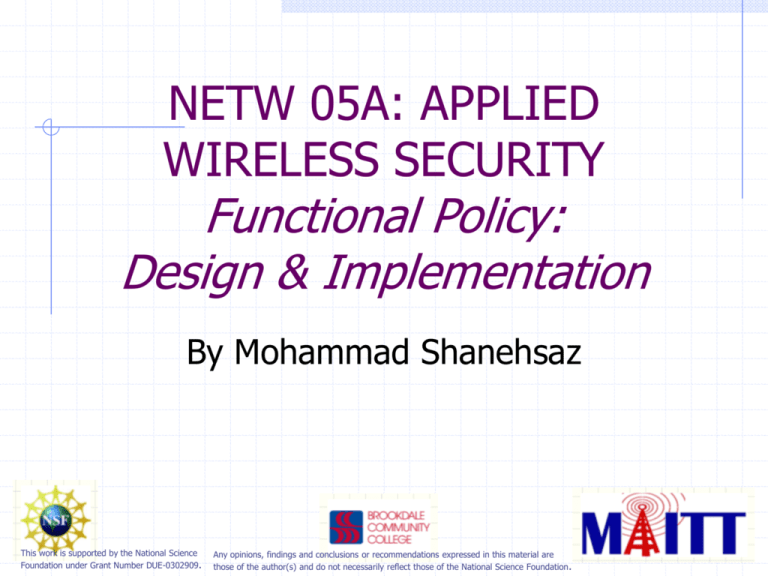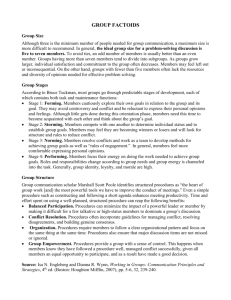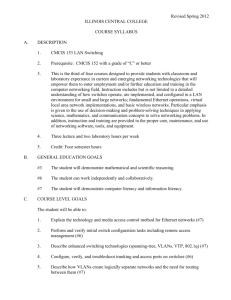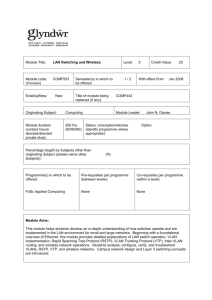Functional Policy: Design & Implementation
advertisement

NETW 05A: APPLIED WIRELESS SECURITY Functional Policy: Design & Implementation By Mohammad Shanehsaz This work is supported by the National Science Foundation under Grant Number DUE-0302909. Any opinions, findings and conclusions or recommendations expressed in this material are those of the author(s) and do not necessarily reflect those of the National Science Foundation. Objectives Given a set of business requirements, design a scalable and secure wireless LAN solution considering the following security tactics: Wireless LAN segmentation Wireless DMZ configuration Use of NAT/PAT NAT/PAT impact on secure tunneling mechanism redundancy This work is supported by the National Science Foundation under Grant Number DUE-0302909. Any opinions, findings and conclusions or recommendations expressed in this material are those of the author(s) and do not necessarily reflect those of the National Science Foundation. Objectives continue Wireless LAN equipment staging & deployment Wireless LAN cell sizing and shaping Scalability Appropriate use of different antenna types Operational verification Secure equipment configuration and placement Secure remote connections to WLAN infrastructure devices Secure solution interoperability and layering This work is supported by the National Science Foundation under Grant Number DUE-0302909. Any opinions, findings and conclusions or recommendations expressed in this material are those of the author(s) and do not necessarily reflect those of the National Science Foundation. Design & Implementation Interoperability Layering Segmentation & VLANS Authentication & Encryption This work is supported by the National Science Foundation under Grant Number DUE-0302909. Any opinions, findings and conclusions or recommendations expressed in this material are those of the author(s) and do not necessarily reflect those of the National Science Foundation. Interoperability Network administrator should take into account interoperability between wireless LAN security solution before making purchases. for example many EAP types are proprietary, and not supported by all vendors PPTP is widely used in small and medium-sized wireless networks for its authentication and encryption VPN features, it is a layer 3 protocol that can be used over the top of any layer 2 solution such as WEP, TKIP, 802.1X/EAP IPSec is a layer 3 VPN technology that supports many encryption ( DES, 3DES, AES ), and has fewer security holes than PPTP, and it can be use the same way as PPTP This work is supported by the National Science Foundation under Grant Number DUE-0302909. Any opinions, findings and conclusions or recommendations expressed in this material are those of the author(s) and do not necessarily reflect those of the National Science Foundation. Layering Using multiple layers of security solution can provide very high levels of security, but it adds a significant amount of complexity to the implementation and administration This work is supported by the National Science Foundation under Grant Number DUE-0302909. Any opinions, findings and conclusions or recommendations expressed in this material are those of the author(s) and do not necessarily reflect those of the National Science Foundation. Layering These four components should be addressed when layering is considered: OSI layer of each solution considered Cost versus benefits Management resources required Throughput & Latency This work is supported by the National Science Foundation under Grant Number DUE-0302909. Any opinions, findings and conclusions or recommendations expressed in this material are those of the author(s) and do not necessarily reflect those of the National Science Foundation. OSI layers Layer 2 ( Data-Link Layer ) WEP ( and all variations such as TKIP ) 802.1X/EAP ( and all variations ) Enterprise Encryption Gateways Layer 2 Tunneling Protocol ( L2TP ) Layer 3 ( Network Layer ) Point-to-Point Tunneling Protocol ( PPTP ) IP Security ( IPSec ) Layer 7 ( Application Layer ) Secure Shell ( SSH ) Secure Shell Version 2 ( SSH2 ) Novel Directory Services ( NDS or eDirectory ) Microsoft Active Directory ( AD ) This work is supported by the National Science Foundation under Grant Number DUE-0302909. Any opinions, findings and conclusions or recommendations expressed in this material are those of the author(s) and do not necessarily reflect those of the National Science Foundation. Cost, Management, Throughput Each layer of solution that is being considered should first be analyzed by itself to determine what costs will be involved in the purchase of any hardware and software because the cost may outweigh the benefits Multiple solutions adds significant cost of administration, not counting user training expenses, and user-friendliness of the solution RF noise and overhead of strong encryption and authentication will affect the overall throughput This work is supported by the National Science Foundation under Grant Number DUE-0302909. Any opinions, findings and conclusions or recommendations expressed in this material are those of the author(s) and do not necessarily reflect those of the National Science Foundation. Segmentation & VLANs All wireless segments should be separated from the network backbone by an access control devices such as Firewalls Enterprise Wireless Gateways Enterprise Encryption Gateways Routers Layer3 Switch VPN Concentrator SSH2 Server VLANs Wireless VLANs This work is supported by the National Science Foundation under Grant Number DUE-0302909. Any opinions, findings and conclusions or recommendations expressed in this material are those of the author(s) and do not necessarily reflect those of the National Science Foundation. Wireless VLANS Wireless VLANs are a relatively new function added to enterprise APs for the purpose of extending VLAN functionality to the mobile client 802.1q VLAN tagging is the most commonly non-proprietary implementation This work is supported by the National Science Foundation under Grant Number DUE-0302909. Any opinions, findings and conclusions or recommendations expressed in this material are those of the author(s) and do not necessarily reflect those of the National Science Foundation. Standard Criteria for VLAN deployment Common applications used by all wireless LAN end user. The WLAN admin should define: Wired network resources commonly accessed by WLAN users QoS level needed by each application This work is supported by the National Science Foundation under Grant Number DUE-0302909. Any opinions, findings and conclusions or recommendations expressed in this material are those of the author(s) and do not necessarily reflect those of the National Science Foundation. Standard Criteria for VLAN deployment Common devices used to access the wireless LAN .The WLAN admin should define: Security mechanisms (WEP,802.1x/EAP) Wired network resources commonly accessed by WLAN device groups QoS level needed by each device This work is supported by the National Science Foundation under Grant Number DUE-0302909. Any opinions, findings and conclusions or recommendations expressed in this material are those of the author(s) and do not necessarily reflect those of the National Science Foundation. VLAN deployment Segmentation by user groups Segmentation by device types This work is supported by the National Science Foundation under Grant Number DUE-0302909. Any opinions, findings and conclusions or recommendations expressed in this material are those of the author(s) and do not necessarily reflect those of the National Science Foundation. Best practices (According to Cisco) Limit broadcast and multicast traffic to the APs and bridges by enabling VLAN filtering and Internet Group Management Protocol snooping on the switch ports Map wireless security policies to the wired infrastructure with ACLs and other mechanisms The AP does not support Virtual Terminal Protocol (VTP) or Generic Attribute Registration Protocol VLAN Registration Protocol (GVRP) for dynamic management of VLANs because the AP acts as a stub node. Enforce network security policies via layer 3 ACLs on the guest and management VLANs, admin force all guest traffic to the Internet gateway, and restrict user access to the native/default VLAN This work is supported by the National Science Foundation under Grant Number DUE-0302909. Any opinions, findings and conclusions or recommendations expressed in this material are those of the author(s) and do not necessarily reflect those of the National Science Foundation. RADIUS-based VLAN access control RADIUS-based SSID access control, upon successful 802.1x/EAP or MAC address authentication, the server passes back the allowed SSID list for the WLAN user to the access point or bridge RADIUS-based VLAN assignment, upon successful 802.1x/EAP or MAC address authentication, the server assigns the user to a predetermined VLAN-ID on the wired side This work is supported by the National Science Foundation under Grant Number DUE-0302909. Any opinions, findings and conclusions or recommendations expressed in this material are those of the author(s) and do not necessarily reflect those of the National Science Foundation. Authentication & Encryption Both are integral parts of any wireless LAN security solution because they specify who can access the network and how the data transmitted is protected Deployment requires following consideration: Existing implementations Data sensitivity Scalability Availability budget This work is supported by the National Science Foundation under Grant Number DUE-0302909. Any opinions, findings and conclusions or recommendations expressed in this material are those of the author(s) and do not necessarily reflect those of the National Science Foundation. Summary The design and implementation section of the Functional Policy covers interoperability, layering, segmentation and VLANs and authentication and encryption Interoperability is the capability of different mechanisms or network processes from different vendors to be able to communicate This work is supported by the National Science Foundation under Grant Number DUE-0302909. Any opinions, findings and conclusions or recommendations expressed in this material are those of the author(s) and do not necessarily reflect those of the National Science Foundation. Summary Layering is utilizing solutions from different layers of the OSI model Segmentation is a method of implementing that divide the network into smaller, more manageable pieces Authentication and encryption help alleviate security risks involved in implementing wireless solutions This work is supported by the National Science Foundation under Grant Number DUE-0302909. Any opinions, findings and conclusions or recommendations expressed in this material are those of the author(s) and do not necessarily reflect those of the National Science Foundation. Resources CWSP certified wireless security professional, from McGrawHill This work is supported by the National Science Foundation under Grant Number DUE-0302909. Any opinions, findings and conclusions or recommendations expressed in this material are those of the author(s) and do not necessarily reflect those of the National Science Foundation.







